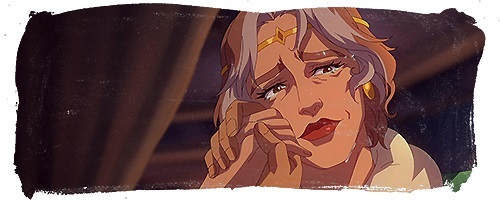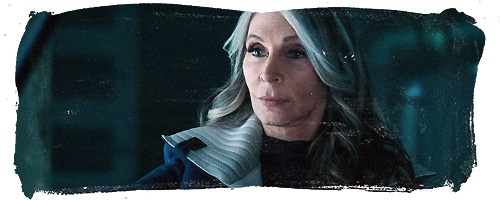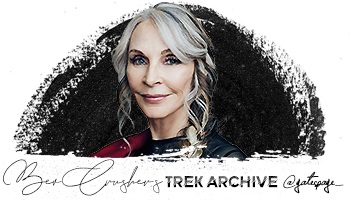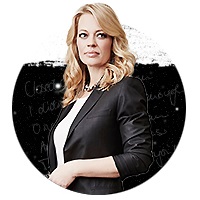
Adam B. Vary
April 13, 2023

Gates McFadden didn’t know what to expect when she first got on a Zoom call with “Star Trek: Picard” executive producers Terry Matalas and Akiva Goldsman. A few years earlier, Patrick Stewart had taken the cast of “Star Trek: The Next Generation” — Jonathan Frakes, LeVar Burton, Marina Sirtis, Michael Dorn, Brent Spiner and McFadden — to dinner to announce that he was going to star on the spinoff series without them. But for the show’s third and final season, Matalas wanted to bring the full cast back together.
The “TNG” storyline ended, some feel prematurely, in 2002, after “Star Trek: Nemesis” bombed in theaters. But for McFadden, her run as Dr. Beverly Crusher had really concluded with the series finale of the show in 1994. In the movies, Crusher — who on the show had a longstanding, unrequited romantic entanglement with Stewart’s Capt. Jean-Luc Picard — had almost nothing to do.
“So much of the history of the character — you didn’t even see it,” McFadden says. “Jean-Luc Picard could have this brand new love interest every time, and it was as if he and Crusher had nothing between them, or ever did. That was a huge part of the character that was just put away.”
To McFadden’s surprise and delight, Matalas pitched her what has turned out to be the most robust storyline her character has ever been given. At some point after the events of “Nemesis,” Crusher and Picard consummated their relationship in a liaison that resulted in a child. Rather than tell Picard, however, Crusher cut herself off from the rest of the crew of the U.S.S. Enterprise-D and raised her son, named Jack Crusher (and played as an adult by “You” co-star Ed Speleers), alone.
The season begins with Crusher reaching out to Picard in desperation as she and Jack are relentlessly hunted by an unknown force. In the penultimate episode of the season, that force is revealed to be the Borg, who in collaboration with a rogue faction of shapeshifting Changelings have successfully infiltrated Starfleet at the highest levels. It turns out that when Picard was assimilated by the Borg during “TNG,” they modified his DNA, which Picard passed along to Jack. That modification, combined with some technological subterfuge that alters the DNA of anyone under 25 in Starfleet, allows the Borg to assimilate the entirety of Starfleet in one cataclysmic stroke.
If that wasn’t enough, the episode ends with one final shocking twist: The “TNG” cast reuniting with the Enterprise-D, which Burton’s Geordi LaForge has painstakingly reconstructed since it was destroyed in the events of 1994’s “Star Trek: Generations.”
McFadden talked with Variety about what it was like to return to the old Enterprise-D and reunite on camera with all her old friends, as well as her own mixed feelings about Crusher’s controversial decision to keep Picard in the dark about his own son — and the “TNG” episode that made her feel better about it.
How did you feel about Beverly Crusher’s presence in the “TNG” movies?
Well, it’s no surprise to hear that it was very disappointing. It’s always tricky when you’re the actor. You want your role to be as wonderful as possible. But you’re also not stupid, and you’re very happy that the franchise is doing well. “First Contact” was just an amazingly written film. My only sadness was that there had to be new female love interests. But then, that’s Hollywood. So you just accept it and do the best you can do with what you’re given. I mean, that’s the job.
So when did you understand that not only would Crusher have that history with Picard on this season of the show, but it would be central to the story?
I think in the very first conversation I had with Terry and Akiva. They told me the storyline. And I said, “Hey, terrific story, but my concern is that she’s not seen as ‘That bitch didn’t tell him she was pregnant with his child! How could she do something like that?’”
She’s basically a very ethical humanist. She really cares about doing the right thing. That was my concern. I was coming from “TNG” where I felt the female point of view was only done through different women characters who would come on board, not Troi or Crusher. I felt that we were lacking in terms of a very strong female presence. Our only scenes, usually we would be, you know, working out and talking about men somehow.
The famous scene of the two of them stretching in leotards.
I mean, it was quite crazy, right? I have enough sense of humor to go, okay, the stupidest scene. I get it. We go to conventions and people are dressed in cosplay with our outfits. It’s funny, and I don’t feel judged by the younger generations, in a way that I wish my generation had gotten it when it happened.
So how did you resolve your feelings about Crusher’s choice about Jack?
I think if we hadn’t had the episode “Attached,” I would have had more of a problem. We had this episode where we were totally connected with each other’s deepest thoughts. I feel that’s why they basically broke up, or it never really went anywhere. Because she didn’t want this on-and-off relationship; she wanted a family. And he very clearly from the deepest instincts did not.
It was crucial for the story that he had a child. I believe it was Patrick who came up with the idea of [the mother] being Crusher. [Sighs] There’re some people who will never forgive her for not telling him. But one of the problems that me, Gates, finds in the world today is that we spend so much time not forgiving, instead of going, maybe I should let go of some of the anger and resentment and open up to the positive. Hey, Picard’s resolved his issues with his parents, and now he has a child. And that child is actually pretty frickin’ great. My children — I don’t know what it says about Crusher’s personality — they all have a bit of a lip. You know, Wesley did, and I think Jack Crusher has some of that too. That’s pretty funny to me.
On “TNG,” Crusher was often a character who was unafraid to go off alone on her own path if she felt it was the right thing to do, rules be damned. Her decision to cut off all her friends and not tell Picard about his son is the most extreme version of that, but I see how people had mixed reactions.
It’s interesting because she didn’t choose to have an abortion. She really wanted to be a mother. And if you’ve just been recently listening to Picard’s deepest thoughts — “no, I would never want a baby, absolutely no, no, no” — I think you have to base it on what she knew then. And I think she hopes that later the child would reunite with Picard, and it’s a shock when her son doesn’t want to. And perhaps she had an instinct, when the child was crying all the time at night, that this child needed protection, and was perhaps a little different. Obviously, there’s going to be people who disagree with [her decision]; I understand that. I just feel also people should then try to focus on maybe the good of why that happened.
At the same time, how did it feel to have so much material to perform as Crusher?
It was the first time ever for me in “Star Trek.” It felt fabulous. It was terrific. I owe that all to Terry. It was wonderful acting again with Patrick. We’ve always had a good chemistry on screen. I never dreamt it was ever going to happen, because I didn’t assume I was going to go back to do a just a one off where I’m, you know, opening a knitting shop or something. That I would not have been interested in.
What was it like the first day the core seven of you were all on set together?
It wasn’t like I hadn’t seen most of them. The only one I hadn’t seen was Marina. The effect on fans in my mind is probably greater than it was for us. We’re in a group text; we’re in each other’s lives. I mean, there was humor. We were sort of, “Okay, we’re back at the Observation Lounge! How are they going to do these shots?” Because in the “TNG” olden days, it would be a whole day in the observation lounge for everyone’s close-up. So it was done in a different way.
What else was different?
The cameras were so fantastic. The lenses were so much sharper. The sound was better. You really notice that it’s been quite a while, 20 years or so — 35 years since we shot the first one. Because I couldn’t make a sound like this. [Drops a pen.] We’d have to reshoot the whole scene before, or I’d have to loop the whole scene. Now, you could make some noise. And I mean, technology has really been rockin it for cameras.
What’s your sharpest memory of being together on set with the cast?
I remember the day Michael Dorn came in and I was shooting that first scene on the Elios. And I was having so much fun because it was an action scene, which I love. I love anything with movement. And then Michael walks on. We had seen each other. We talk to each other all the time. But we both just hugged each other and we’re like, “This is so cool!” That’s the one I remember the most, because he was the first one I actually saw. And then there was this moment when Patrick, Jonathan and me were on the bridge of the Titan. And we were like wow, we are all in uniform and doing this. I mean Patrick had been doing this, but for Jonathan and me, it was special. It was really special. And then, of course, when everybody came on. I love these people. They’re terrific actors. But people forget it was during COVID. So we always had our masks on, and because the sound was so good, we couldn’t talk. We didn’t have our own little trailers outside where we used to cause havoc. We were much more behaved.
LeVar Burton and Brent Spiner told me the same thing, that you’re “older” and “more mature” now.
I think that’s definitely true, but I’m not sure that given the right circumstances, we wouldn’t still be singing on a set or whatever. There was one moment where we went crazy with it. But poor Terry had a lot to shoot in a limited time, and I think we were all aware of that. So maybe narcissistically we were more well behaved because we wanted it to be good. We wanted the first one to be good. That’s silly to say. But we had much longer hours. So I think after you’ve shot for 14 hours, you start to get incredibly silly.
So when did you learn that the Enterprise-D was going to be resurrected?
I think pretty early on. That was amazing. It was a huge visceral difference. The Titan was an intimidating bridge. Even the Gates part of it that was like, “Wow, if I were on this bridge, I wouldn’t know how to work all those machines.” Whereas on the Enterprise bridge, I was like, “Oh, yeah, I can do it all. I know how to drive it.”
It was interesting to see the difference in the lighting, for example. The original “TNG” bridge is like a living room. My little boy, he was learning how to walk on that bridge. He was going up and down and into the ready room and looking at the fish and the spaceship model. It really was this homey feeling. And it also seems really small compared to the technology and the size and the scope of the Titan.
How closely did they recreate the original “TNG” bridge?
[Whispers] Very. Very. Amazing. They had the same stuff, things that you’d be reading that would be from the show. [“TNG” graphic designer] Michael Okuda helped them with all those little details. He’s such a genius. He and his wife Denise just figured all of those things out.
Did you see it for the first time the day you shot?
I had seen it before. I went over. I wanted to see it.
As you’ve said, the “TNG” cast has been close for a long time, but what was it like to be on that set together for the first time since 1994’s “Star Trek: Generations”?
It just felt like home. You knew where to go, what to hold, where to run for this control and that control. I think it’s for the fans almost more exciting in a sense, because they’re seeing the whole. When I see it in the context of the episode, it’s powerful. When you’re acting it in the space, I had seen it before. It was just like going to a museum and seeing it. It was just lovely. I think that’s all I can say, you know. We had all the shots to fit in. But it wasn’t like, you know, we all burst into tears. What Terry and the editors have done is pretty great. It’s really dramatic and powerful.
Did you like where you were standing?
In the first series, I would sit down, either next to Riker’s seat or on one of those two sides. But it was great fun to be up there in the Worf spot. Worf and I up there brought out my inner Klingon.
Terry’s made no secret that he would love to continue this storyline on a new show that he wants to call “Star Trek: Legacy.” Would you want to continue playing Crusher?
If she was as three dimensional as she was really becoming in this one? Absolutely. And, as I said, I trust Terry. I’ll play a Klingon for Terry. I mean, he’s really a wonderful, wonderful producer and writer, storyteller. And I love good storytellers. I built a theater in L.A., and we did only new work. I think people who can tell a story, I’ll be the first one to jump on board to help out. I hope it does. I think he would do a tremendous job. And I would love to be involved in some way.














